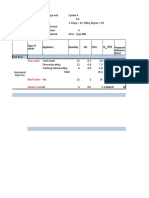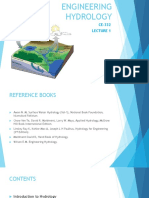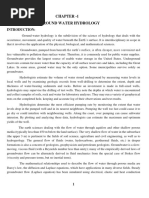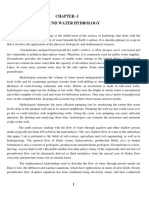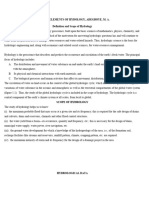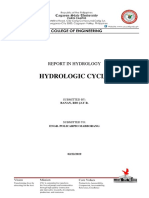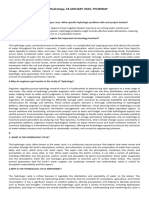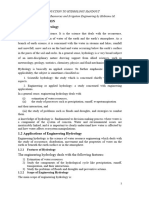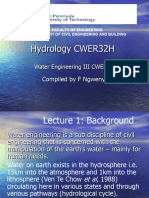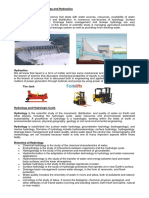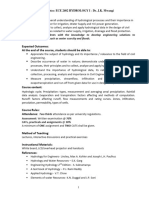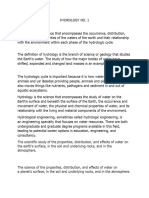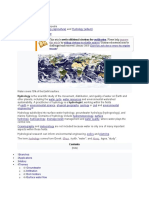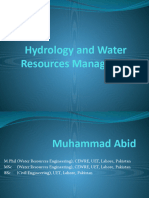Cve 323 (Fluid Dynamic & Hydrology)
Cve 323 (Fluid Dynamic & Hydrology)
Uploaded by
ernestnariCopyright:
Available Formats
Cve 323 (Fluid Dynamic & Hydrology)
Cve 323 (Fluid Dynamic & Hydrology)
Uploaded by
ernestnariOriginal Title
Copyright
Available Formats
Share this document
Did you find this document useful?
Is this content inappropriate?
Copyright:
Available Formats
Cve 323 (Fluid Dynamic & Hydrology)
Cve 323 (Fluid Dynamic & Hydrology)
Uploaded by
ernestnariCopyright:
Available Formats
CVE 323 Fluid Dynamics & Hydrology
Kebbi State University of Science and 2Unit
Technology, Alieru
FLUID DYNAMICS &
HYDROLOGY
INTRODUCTION TO HYDROLOGY
Hydrology, by its term meaning is the science of water. However it does not gives a complete
view of hydrology in respect to water generating source for creating water resource on earth
system, essential for mankind. After a great exercise and deal the scientists defined the
hydrology as the science dealing the occurrence of rainfall, its distribution & circulation on and
below the earth and physical and chemical reaction with earth materials. Hydrology deals with
the waters of the earth, their distribution and circulation, their physical and chemical properties,
and their interaction with the environment, including interaction with living things and, in
particular, human beings. Engineering hydrology includes those segments of the field pertinent
to design and operation of engineering projects for the control and use of water.
In hydrology, the land unit is the watershed, which also may be referred to as a basin or
catchment.
A watershed is defined as an area of land in which all of the incoming precipitation drains (i.e.,
“sheds”) to the same place – toward the same body of water or the same topographic low area
(e.g., a sinkhole) – as a result of its topography. This means that a watershed's boundary is
defined by its topographic high points. Watersheds are fairly simple to identify in mountainous
or hilly terrain because their boundaries are defined by ridges (Figure 1). However, in flatland
watersheds, such as in the Coastal Plain of the Southeast, identifying topographic high points can
be very challenging because the highest and lowest elevations may differ only by a few
centimetres.
Practical Applications of Hydrology
I. Design and operation of hydraulic structures
II. Water supply
III. Waste water treatment and disposal
IV. Irrigation and drainage
V. Hydropower generation
VI. Flood control
VII. Navigation
VIII. Erosion and sediment control
IX. Salinity control
X. Recreational use of water
XI. Fish and wildlife protection
Scope of hydrology
Hydrology is an indispensable tool in planning and building hydraulic structures.
Fluid Dynamics & Hydrology Page 1 of 5
Hydrology is used for city water supply design which is based on catchments area,
amount of rainfall, dry period, storage capacity, runoff evaporation and transpiration.
Dam construction, reservoir capacity, spillway capacity, sizes of water supply pipelines
and affect of afforest on water supply schemes, all are designed on basis of hydrological
equations.
The variation of water production from catchments can be calculated and described by
hydrology.
Engineering hydrology enables us to find out the relationship between a catchments’s
surface water and groundwater resources
The expected flood flows over a spillway, at a highway at a Culvert, or in an urban storm
drainage system can be known by this very subject.
It helps us to know the required reservoir capacity to assure adequate water for irrigation
or municipal water supply in droughts condition.
It tells us what hydrologic hardware (e.g. rain gauges, stream gauges etc) and software
(computer models) are needed for real-time flood forecasting
Used in connection with design and operations of hydraulic structure
Crop planning based on available water in the area.
Divisions of Hydrology:
Hydrology can generally be divided into two main branches
Surface Water Hydrology: It is the study of hydrologic processes that operate at or near earth’s
surface.
Ground Water Hydrology: It is the study of underground water.
Engineering Hydrology: Engineering hydrology deals with the planning, design and Operation
of Engineering projects for the control and use of water
Applied Hydrology: Applied hydrology is the study of hydrological cycle, precipitation, runoff,
relationship between precipitation and runoff, hydrographs, Flood Routing
Chemical Hydrology: Study of chemical characteristics of water.
Eco-hydrology: Interaction between organisms and the hydrological cycle.
Hydrogeology: Also referred to as geo-hydrology, is the study of the presence and movement of
ground water.
Hydro-informatics: is the adaptation of information technology to hydrology and water
resource applications
Hydrometeorology: It is the study of the transfer of water and energy between land and water
body surfaces and the lower atmosphere.
Isotope Hydrology: It is the study of isotropic signatures of water (origin and age of water).
DISTRIBUTION OF WATER ON THE EARTH
The Table 1.1 lists estimated quantities of water in various forms on the earth. About 96.5% of
all the earth’s water is in the oceans. If the earth were a uniform sphere, this quantity would be
sufficient to cover it to a depth of about 2.6 km. Of the remainder, 1.7% is in the polar ice, 1.7%
in groundwater and only 0.1% in the surface and atmospheric water systems. The atmospheric
water system, the driving force of surface water hydrology, contains only 12,900 km 3 of water,
or less than one part in 100,000 of all the earth’s water. The earth’s fresh water, about two-thirds
is polar ice and most of the remainder is groundwater going down to a depth of 200 to 600 m.
Most groundwater is saline below this depth. Only 0.006% of fresh water is contained in the
Fluid Dynamics & Hydrology Page 2 of 5
rivers. Biological water, fixed in the tissues of plants and animals, make up about 0.003% of all
fresh water, equivalent to half the volume contained in rivers.
Table 1.1: Estimated world water quantities
Where does the water go? To make things… to clean things….
Where does the water go? To make
Gallons
things…to clean things…. Item
1 pound of cotton 2,000
1 pound of grain-fed beef 800
1 loaf of bread 150
1 car 100,000
1 kilowatt of electricity 80
1 pound of rubber 100
1 pound of steel 25
1 gallon of gasoline 10
1 load of laundry 60
1 ten-minute shower 25-50
Some points:
A lot of water is used for agriculture
56% (76 BGD) is consumptive use
Fluid Dynamics & Hydrology Page 3 of 5
20% (28 BGD) is lost in conveyance
24% (33 BGD) is return flow
A lot of water is used for thermoelectric power generation
87% of all industrial water use
A small savings in either of these categories would free up significant quantities for public
supplies.
THE HYDROLOGIC CYCLE
It refers to the continuous circulation of water within the earth’s hydro-sphere.
Water moves into and from the various sources on, over and below the earth, with the total mass
of water remaining fairly constant. The water cycle is highly crucial to maintain the life on earth,
as it replenishes the world’s freshwater resources and moderates extremes in climate. The
physical processes involved in hydrologic cycle are
Evaporation
Condensation
Sublimation
Precipitation
Transpiration,
Interception,
Infiltration,
Percolation and
The runoff
Sun is the source of energy to activate
Evaporation - It involves the vaporization of water from the water sources due to heat
energy of solar radiation. The evaporated water gets converted into cloud. Through which
water gets fall on the earth system in terms of precipitation. In water transfer process
about 90% of atmospheric water is contributed by evaporation.
Condensation- It refers to the transformation of evaporated water vapours into liquid
water droplets suspended in the air as clouds or fog. It is important process to convert the
evaporated water into liquid state enabling formation of clouds with the aid of
condensation nuclei.
Sublimation- This is the process in which there is direct conversion of solid ice into
water vapour. By this process water mass is also added to atmosphere for cycling.
Precipitation- It is the fall of atmospheric water to the ground surface. Under this
process the water becomes available for its distribution (surface and sub-surface) and
circulation on the above and below the earth surface. It mostly takes place in the form of
liquid (rainfall) and very little in solid form (snow, sleet, hail fog etc.)
Transpiration- It is a process of water loss from plants' leaves through respiration. The
water loss through transpiration and evaporation coupled together is referred to
Evapotranspiration (ET). In hydrologic cycle about 10% water or moisture is added to the
atmosphere by transpiration process.
Interception- This is the process in which a part of precipitation is abstracted by the
objects lying on the ground surface. The objects may be the crop, tree, natural vegetations
and any other in live or dead conditions. Intercepted precipitated water is ultimately lost
Fluid Dynamics & Hydrology Page 4 of 5
through evaporation process. Rate and quantity of water loss under this process varied
with the type and characteristics of vegetation/objects and climatic condition, mainly.
Infiltration- It is defined as the entry of water into the soil by crossing the imaginary
boundary between soil and atmosphere and its rate called infiltration rate. Under this
process the precipitated water moves into the soil media and ultimately joins to the water
–table or deposited on impervious layer, if there occurs across water movement path. It is
treated as the input process for ground water occurrence.
Runoff- The flow of joined rain water in the stream is designated as the channel flow or
the runoff. The characteristics associated to the climate and watershed affects the
quantum of runoff at the outlet. Runoff is categorised into surface and sub-surface runoff.
In which surface runoff is that part of the runoff which travels over the ground surface
thought the channels/ streams /rivers to reach the basin outlet, and sub- surface or indirect
runoff points to the flow of precipitated water below the soil surface leading to water-
table. The view of hydrologic cycle is presented in Fig-
Fluid Dynamics & Hydrology Page 5 of 5
You might also like
- ArcSWAT Documentation 2012Document464 pagesArcSWAT Documentation 2012puja76100% (12)
- Introduction To Water Resources EngineeringDocument11 pagesIntroduction To Water Resources EngineeringMayolites100% (1)
- S&W CalculationDocument10 pagesS&W CalculationSameera LakmalNo ratings yet
- Hydrology Lecture 1Document31 pagesHydrology Lecture 1Noman Zafar100% (1)
- SWC 201 - Watershed Hydrology - All Lectures 2 4Document3 pagesSWC 201 - Watershed Hydrology - All Lectures 2 4CAVEMAN MUSCLENo ratings yet
- 4_6001090788878980899Document49 pages4_6001090788878980899gemechisNo ratings yet
- Hydrology 1Document41 pagesHydrology 1hazelanncabinianNo ratings yet
- Hydrology 1Document4 pagesHydrology 1Kei KagayakiNo ratings yet
- Chaptar 1 Hydrology and Hydrometerology (Final)Document37 pagesChaptar 1 Hydrology and Hydrometerology (Final)Muhammad Waseem YaseenNo ratings yet
- Ground Water HydrologyDocument24 pagesGround Water HydrologyKonda Ramesh Reddy100% (1)
- Ground Water Hydrology PDFDocument24 pagesGround Water Hydrology PDFKonda Ramesh Reddy100% (1)
- Environmental HydrologyDocument60 pagesEnvironmental HydrologyAbelNo ratings yet
- Concepts of HydrogeologyDocument3 pagesConcepts of HydrogeologyT N Roland BourgeNo ratings yet
- Chaptar 1 Hydrological Cycle (Final)Document12 pagesChaptar 1 Hydrological Cycle (Final)Ameer HamzaNo ratings yet
- BCE 3102 Hydrology and Hydraulics - Lecture 2 (The Hydrologic and Carbon Cycle)Document29 pagesBCE 3102 Hydrology and Hydraulics - Lecture 2 (The Hydrologic and Carbon Cycle)Philip TibenderanaNo ratings yet
- Engr. Hassan Khan Lecturer CED, SUIT, PeshawarDocument18 pagesEngr. Hassan Khan Lecturer CED, SUIT, Peshawarafi khanNo ratings yet
- Hydraulics and Hydrology - Lecture 1 (Introduction - The - Hydrologic - and - Carbon - Cycle)Document29 pagesHydraulics and Hydrology - Lecture 1 (Introduction - The - Hydrologic - and - Carbon - Cycle)joelkyeswa97No ratings yet
- Emp 316.2, Complete-Note, 2023Document53 pagesEmp 316.2, Complete-Note, 2023uc211heNo ratings yet
- Hydrology and Water Resources Management: Noor M Khan 2021Document39 pagesHydrology and Water Resources Management: Noor M Khan 2021EPICgh BEASTghnNo ratings yet
- Report in HydrologyDocument6 pagesReport in Hydrologyrio jay bananNo ratings yet
- Introduction To HydrologyDocument47 pagesIntroduction To HydrologyCt Kamariah Md SaatNo ratings yet
- Environmental HydrologyDocument88 pagesEnvironmental HydrologyTigist TameneNo ratings yet
- 17CV73 .HydrologyDocument100 pages17CV73 .HydrologyRavi Kumar C NNo ratings yet
- HYDROLOGYDocument25 pagesHYDROLOGYSurekha Abhishek Rao100% (1)
- CE100 Lec 17 Water - 1Document27 pagesCE100 Lec 17 Water - 1sabbir12488No ratings yet
- Chap1&2 and Tutorials-HydrologyDocument119 pagesChap1&2 and Tutorials-HydrologyingenzihubertNo ratings yet
- Lecture2HE2023Document30 pagesLecture2HE2023sardorkhamidowNo ratings yet
- Ce322 AssignmentDocument2 pagesCe322 AssignmentAloysius LaparaNo ratings yet
- HydrologyDocument38 pagesHydrologyMelannie ArgenteraNo ratings yet
- Learning Module: Surigao State College of TechnologyDocument5 pagesLearning Module: Surigao State College of TechnologyCyralie MaglipacNo ratings yet
- Chapter 2Document20 pagesChapter 2Rushed AlamaNo ratings yet
- Introduction To HydrologyDocument74 pagesIntroduction To HydrologyhabtamuNo ratings yet
- Lesson 1 Hydrology Introduction 2 2010Document25 pagesLesson 1 Hydrology Introduction 2 2010Zithulele TreatwellNo ratings yet
- Lec 2, Introduction To HydrologyDocument18 pagesLec 2, Introduction To HydrologyAsadullah Khan GhalibNo ratings yet
- Hydrology: Outline of Hydrology Hydrology (Agriculture) Hydrology (Album)Document8 pagesHydrology: Outline of Hydrology Hydrology (Agriculture) Hydrology (Album)Pete BasNo ratings yet
- Water Resources Engineering PDFDocument259 pagesWater Resources Engineering PDFEfraim PablacioNo ratings yet
- HydrologyDocument6 pagesHydrologyRaman LuxNo ratings yet
- CIVE2304 C1-1 Hydrological CycleDocument54 pagesCIVE2304 C1-1 Hydrological CyclenaserNo ratings yet
- 1-2 Hydrology & Hydrologic Cycle & Watershed DefinitionDocument4 pages1-2 Hydrology & Hydrologic Cycle & Watershed Definitioncat buenafeNo ratings yet
- Hydrology Lesson 2 PDFDocument8 pagesHydrology Lesson 2 PDFhey cuteNo ratings yet
- Hydrologic CycleDocument7 pagesHydrologic CycleEmmanuel AtakosNo ratings yet
- Hydrology Week 1 3Document14 pagesHydrology Week 1 3Hillary JadeNo ratings yet
- 1-2-Hydrologic CycleDocument34 pages1-2-Hydrologic Cyclekhansartajalam8No ratings yet
- Sivakumar2017 Chapter IntroductionDocument25 pagesSivakumar2017 Chapter IntroductionA GBNo ratings yet
- Hydrologic CycleDocument4 pagesHydrologic CycleDEXTURENo ratings yet
- Concepts of HydrologyDocument8 pagesConcepts of HydrologyCamille SantosNo ratings yet
- Ce 324 Updated LectureDocument32 pagesCe 324 Updated LectureCharles William ValentonNo ratings yet
- Hydrology: Hydrology (Agriculture) Hydrology (Album) Outline of HydrologyDocument6 pagesHydrology: Hydrology (Agriculture) Hydrology (Album) Outline of HydrologyBernard PalmerNo ratings yet
- Module 1Document26 pagesModule 1Afroz AhamedNo ratings yet
- Lecture Notes - HydroDocument55 pagesLecture Notes - HydroAlvin Deliro100% (5)
- Hydrology Water Kesources: A Biological Cell Is Usually Made Up of at Least 70%Document32 pagesHydrology Water Kesources: A Biological Cell Is Usually Made Up of at Least 70%Alyssa Sen MedinaNo ratings yet
- Introduction to HydrologyDocument15 pagesIntroduction to HydrologyChunsa ParkNo ratings yet
- ABEN55a - Lecture 01Document3 pagesABEN55a - Lecture 01Karylle Anne MontoyaNo ratings yet
- Chapter 1 - Basic HydrologyDocument32 pagesChapter 1 - Basic Hydrologyhayati morsidi100% (1)
- 2ème Cours - HydrologyDocument4 pages2ème Cours - HydrologyBroomNo ratings yet
- Hydrology: Cagayan State University-Carig CampusDocument8 pagesHydrology: Cagayan State University-Carig CampusRomel DecenillaNo ratings yet
- Hydrology Lec 1Document54 pagesHydrology Lec 1christianNo ratings yet
- Hydrology Lesson 1Document7 pagesHydrology Lesson 1James Tangi-an WhatimNo ratings yet
- Chapter-1-Study-Guide-in-HydrologyDocument11 pagesChapter-1-Study-Guide-in-HydrologyCrispin NasamNo ratings yet
- Hydrology Is The Study of The Movement, Distribution, and Quality ofDocument8 pagesHydrology Is The Study of The Movement, Distribution, and Quality ofkamdemonnNo ratings yet
- TIMES Roman Book PagesDocument100 pagesTIMES Roman Book PagesyashaswiniNo ratings yet
- Hydraulic Analysis: For Reinforced Concrete Box CulvertDocument7 pagesHydraulic Analysis: For Reinforced Concrete Box Culvertmarkgil1990100% (1)
- Introduction To Highway HygraulicsDocument218 pagesIntroduction To Highway HygraulicsVangjush Mbrice100% (1)
- Alemayehu Book 2006 Ethiopia Groundwater Occurrence Hydrogeological Water Quality AquiferDocument107 pagesAlemayehu Book 2006 Ethiopia Groundwater Occurrence Hydrogeological Water Quality AquiferAbiued Ejigue100% (6)
- Sileshi Mamo, Behailu Birhanu, Tenalem Ayenew, Getnet TayeDocument17 pagesSileshi Mamo, Behailu Birhanu, Tenalem Ayenew, Getnet Tayesileshi.mamoNo ratings yet
- Survey 20191civ9001 DINAKAR NAIK A TDocument175 pagesSurvey 20191civ9001 DINAKAR NAIK A Tshashanknaikat5No ratings yet
- Instant Ebooks Textbook Um Mar Sem Estrelas 1st Edition Erin Morgenstern Download All ChaptersDocument34 pagesInstant Ebooks Textbook Um Mar Sem Estrelas 1st Edition Erin Morgenstern Download All ChaptersouabelaartNo ratings yet
- CE141-2 Module 1 Exam Part 1Document1 pageCE141-2 Module 1 Exam Part 1AIZENNo ratings yet
- Rational Method PDFDocument8 pagesRational Method PDFRandel Boris de OcampoNo ratings yet
- Implementation of Swachh Bharat in MysoreDocument13 pagesImplementation of Swachh Bharat in MysoreDipyaman ChoudhuryNo ratings yet
- West Flowing Rivers of Kutch and Saurashtra Including Luni BasinDocument142 pagesWest Flowing Rivers of Kutch and Saurashtra Including Luni BasinpujaNo ratings yet
- Mine Rehabilitation HandbookDocument58 pagesMine Rehabilitation Handbookedatgka100% (1)
- Estimation On Time of Concentration of Overland Flow in Watersheds A ReviewDocument12 pagesEstimation On Time of Concentration of Overland Flow in Watersheds A Reviewpablopadawan1No ratings yet
- At-Site and Regional Flood Frequency Analysis of The Upper Awash Sub Basin in The Ethiopian PlateauDocument15 pagesAt-Site and Regional Flood Frequency Analysis of The Upper Awash Sub Basin in The Ethiopian PlateauRahulKumarSinghNo ratings yet
- 7 PDFDocument12 pages7 PDFJoshua Bacunawa100% (1)
- Annex 6Document16 pagesAnnex 6Manusha MaureeNo ratings yet
- Dhibaayyuu LDP1Document32 pagesDhibaayyuu LDP1Dagim HailuNo ratings yet
- Water Resources of IndiaDocument22 pagesWater Resources of IndiaSatishkumar KashidNo ratings yet
- Barrage DesignDocument45 pagesBarrage DesignKumar VivekNo ratings yet
- LECTURE 5-Measurement of Water Yield From WatershedDocument23 pagesLECTURE 5-Measurement of Water Yield From WatershedChu DicksonNo ratings yet
- Management of Natural ResourcesDocument35 pagesManagement of Natural ResourcesMiraaj Kadam67% (3)
- Literature Review On Poor Drainage SystemDocument7 pagesLiterature Review On Poor Drainage Systemafdtsadhr100% (2)
- Drainage in Dehradun CityDocument2 pagesDrainage in Dehradun CityAchal GargNo ratings yet
- Cross Sectoral Validation of Indigenous Technical Knowledge in AgricultureDocument225 pagesCross Sectoral Validation of Indigenous Technical Knowledge in AgricultureGatewayconsultancy ServicesNo ratings yet
- Tatek WorkuDocument92 pagesTatek Workuesttif02No ratings yet
- Class - IX Drainage WorksheetDocument4 pagesClass - IX Drainage Worksheetyamini.takwaleNo ratings yet
- Full Thesis Shivan and JadhavDocument311 pagesFull Thesis Shivan and Jadhavmandypatil88No ratings yet
- The Hydraulic SystemDocument42 pagesThe Hydraulic SystemNaseerSobreeNo ratings yet


